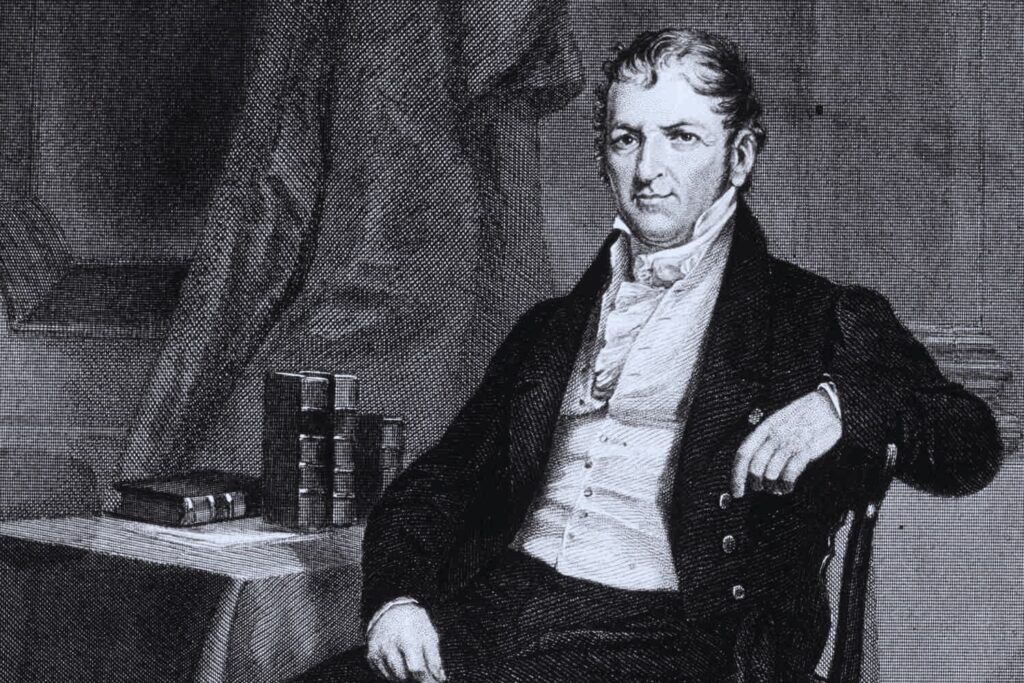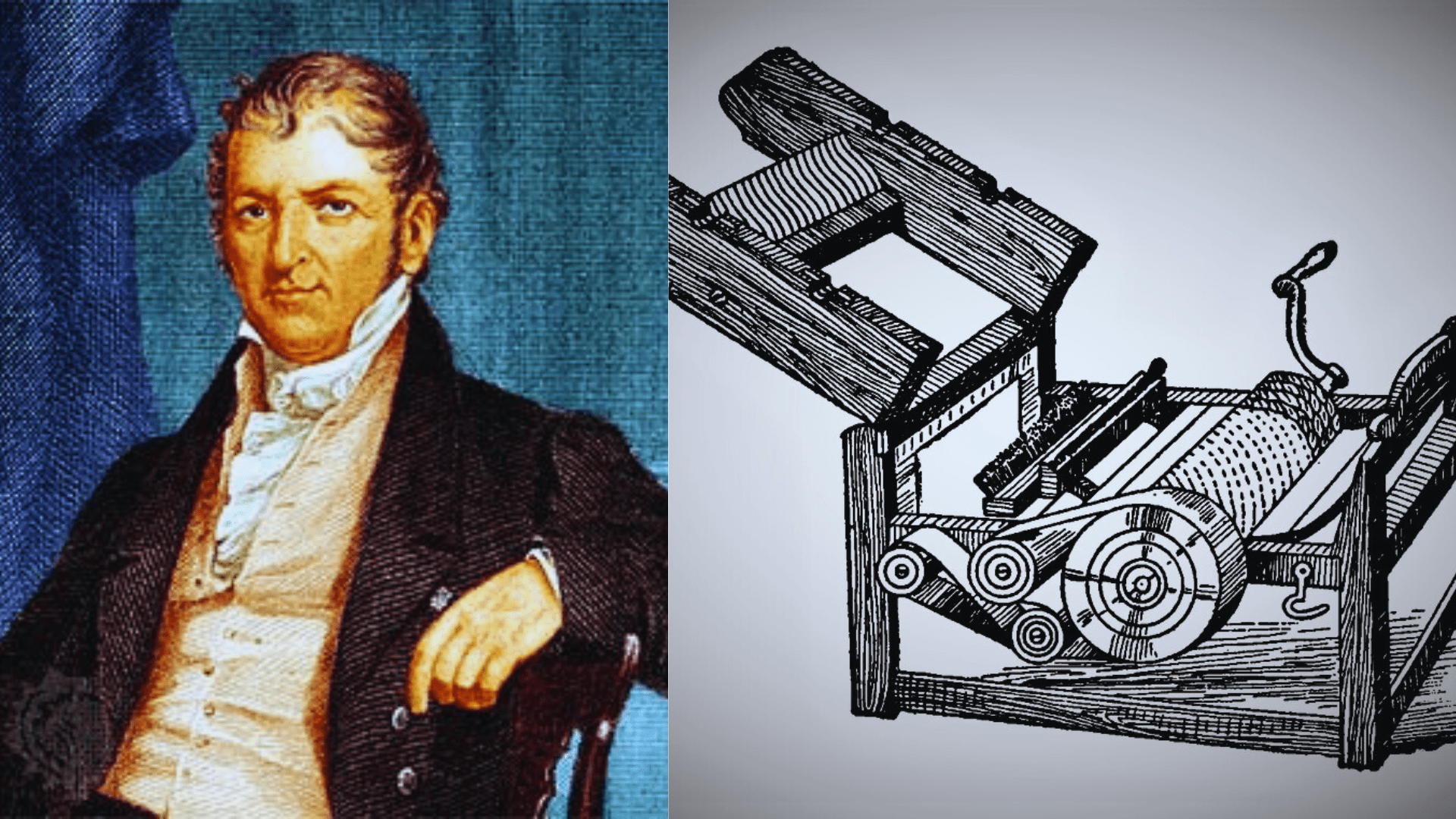The cotton gin, a groundbreaking invention that dramatically transformed the production of cotton, was invented by Eli Whitney in 1793. This machine revolutionized the cotton industry by efficiently separating cotton fibers from their seeds, thereby significantly enhancing the production process. Whitney’s invention is credited with fixing the South’s economy on cotton and, by extension, on slavery, highlighting its profound socio-economic impact. Eli Whitney patented the cotton gin in 1794, marking a significant milestone in agricultural and industrial history.
The Invention of the Cotton Gin
The Need for the Cotton Gin
Before the invention of the cotton gin, the cotton industry faced significant challenges that hampered its production and profitability. Cotton deseeding was a labor-intensive and time-consuming process, requiring extensive manual labor to remove seeds from cotton fibers. This slow process limited the amount of cotton that could be processed and significantly increased production costs. As a result, the cotton industry was not as profitable or efficient as it could be, leading to a demand for a solution that could streamline cotton processing and reduce reliance on manual labor. The cotton gin, invented by Eli Whitney, addressed these challenges by mechanizing the separation of cotton seeds from fiber, drastically reducing the time and labor required for cotton processing. However, while it made cotton processing more efficient, it paradoxically increased the demand for enslaved labor to plant and harvest the cotton, thus having a mixed legacy.
The Brilliant Mind Behind the Invention

Eli Whitney Jr. (December 8, 1765 – January 8, 1825) was an American inventor best known for inventing the cotton gin in 1793. This invention dramatically transformed the cotton industry by making the process of separating cotton fibers from their seeds much more efficient, thereby revolutionizing the agricultural sector in the United States. Aside from the cotton gin, Whitney is also credited with promoting the idea of interchangeable parts in manufacturing, a concept that laid the groundwork for modern mass production techniques. Born in Westborough, Massachusetts, Whitney was not only a mechanical engineer and manufacturer but also a pioneer whose innovations extended beyond a single invention, affecting the industrial and agricultural landscapes of his time. His work earned him a place as a key figure in American technology and industry.
How the Cotton Gin Works
The Basic Components
A cotton gin, crucial for cleaning cotton of its seeds, consists primarily of several key components designed to streamline the process of separating cotton fibers from their seeds and other debris. The basic parts include:
- Feeder System: Introduces raw cotton into the gin.
- Cleaning Unit: Removes large debris using a series of spiked drums in an incline cleaner, as part of the initial cleaning phase.
- Ginning Unit: Uses a combination of mechanical actions to separate the fibers from the seeds. This is where the cotton is firmly grasped and pulled through a series of small wire teeth, leaving the seeds behind because they are too large to pass through.
- Lint Cleaning System: Further cleans the lint of smaller particles and debris after the seeds have been removed.
- Baling Press: Compresses the clean lint into bales for transport and sale.
- Waste Handling System: Manages the by-products such as seeds (fuzzy seed) and other residuals (gin trash).
The efficiency and functionality of these components have made the cotton gin a game-changing invention in the textile industry.
The Process of Ginning Cotton
The process of ginning cotton involves several key steps to prepare cotton fibers for the next stages of textile production, primarily focusing on separating the fibers from the seeds:
- Preparation: Cotton lobes are removed from the husk, and stretched lengthwise to expose the fibers and seeds for easier processing.
- Moisture Measurement: Before ginning begins, the moisture level of the cotton is measured to ensure optimal conditions for effective fiber and seed separation.
- Drying: Cotton then goes through dryers to reduce its moisture content, preparing it for the separation process.
- Ginning: During this crucial step, the cotton fibers (lint) are mechanically separated from the seeds. This is achieved by feeding the cotton into a machine where the fibers are pulled away by a series of small wire hooks, leaving the seeds behind.
This streamlined process is essential for converting raw cotton into a material suitable for spinning into yarn, highlighting the cotton gin’s importance in textile manufacturing.
The Impact of the Cotton Gin
Revolutionizing Cotton Production
The invention of the cotton gin by Eli Whitney in 1793 significantly transformed cotton production in several ways:
- Increased Efficiency: The cotton gin greatly improved the efficiency of separating cotton fibers from seeds, a task that was previously labor-intensive and time-consuming. This mechanization allowed for faster processing of cotton.
- Economic Impact: With the ability to process cotton more rapidly, the demand for cotton surged, leading to its dominance as the largest cash crop in the South, surpassing even tobacco. “Cotton is King” became a commonly used phrase to describe the crop’s significance.
- Expansion of Slavery: Despite reducing the labor needed to remove seeds from cotton, the cotton gin inadvertently increased the demand for slaves and plantations because more labor was needed to grow and pick cotton. This led to a substantial investment in slavery by Southern plantation owners.
- Geographical and Economic Expansion: The cotton gin’s efficiency facilitated the geographical expansion of cotton farming into new territories, contributing to the growth of the American economy and further entrenching the institution of slavery.
Overall, while the cotton gin was a landmark invention that revolutionized cotton production, it also had profound and unintended social consequences, particularly in the reinforcement and expansion of slavery in the United States.
Economic Boom and Expansion
The cotton gin, invented by Eli Whitney in the late 18th century, had a profound impact on the economic growth and territorial expansion of the United States:
- Boost in Cotton Production: By efficiently separating cotton fibers from their seeds, the cotton gin made it feasible to process short-staple cotton, which thrived in the Deep South but was previously too labor-intensive to process profitably.
- Expansion of Slavery: The increased productivity led to a greater demand for labor, particularly in the form of slavery. As cotton cultivation became more profitable, it expanded further into the South and West, increasing the demand for enslaved workers to cultivate and harvest the crop.
- Economic Growth: The cotton gin contributed significantly to the U.S. economy by making cotton a dominant cash crop. This led to vast economic growth throughout the Southern region, as planters earned greater profits, which in turn prompted them to grow larger cotton crops.
- Geographical Expansion: The lucrative nature of cotton farming fueled geographical expansion into new territories, further entrenching the agricultural economy’s reliance on slavery and setting the stage for significant socio-economic and political developments in the United States.
In summary, the cotton gin played a central role in the economic boom and territorial expansion of the early United States, while also intensifying the reliance on slavery, thus having a lasting impact on the nation’s history.
Socio-Political Ramifications
The invention of the cotton gin by Eli Whitney had profound unintended socio-political ramifications, notably the intensification of slavery in the United States:
- Increase in Slavery: Contrary to expectations that it might reduce the labor needed to process cotton, the cotton gin significantly increased the demand for slave labor. Plantations could process cotton much more efficiently, making cotton cultivation far more profitable and expanding the geographic area suitable for cotton farming. This expansion led to a surge in the demand for slaves to work in the fields.
- Economic Dependence: The Southern economy became even more entrenched in slavery due to the profitability of cotton. This dependence on slave labor for economic prosperity deepened the divisions between the Northern and Southern states, contributing to the socio-political tensions that eventually led to the Civil War.
- Contrary to Founders’ Expectations: Some of the Founding Fathers believed that slavery would naturally decline due to social pressures or the unprofitability of slave-produced crops. The cotton gin’s efficiency in processing cotton upended these expectations, making slavery even more entrenched and profitable, contrary to the hopes for its gradual abolition.
In summary, the cotton gin’s introduction had the unintended consequence of intensifying slavery, entrenching economic dependence on this institution in the South, and exacerbating socio-political divides that led to the Civil War.
The Legacy of the Cotton Gin
Innovations Stemming from the Gin
Fundamentally transformed the cotton industry by mechanizing the separation of cotton fibers from seeds. This innovation not only revolutionized cotton processing but also inspired further technological advancements and methodologies across various sectors:
- Mechanization of Agriculture: The cotton gin’s success illustrated the benefits of mechanizing labor-intensive processes. It spurred the development of other agricultural machines, like the mechanical reaper and the threshing machine, which further revolutionized farming practices.
- Industrial Revolution: The efficiency introduced by the cotton gin contributed to the Industrial Revolution by providing a model for mass production and mechanization in industries beyond agriculture. This led to the development of manufacturing technologies that relied on similar principles of mechanization and efficiency.
- Technological Innovations in Textile Industry: The demand for processed cotton fueled innovations in the textile industry, leading to the development of power looms and spinning jennies. These inventions increased the speed and efficiency of textile production, mirroring the impact of the cotton gin on cotton processing.
- Impact on Commodity Markets: The cotton gin’s effect on the cotton industry showcased how technological innovations could dramatically alter the supply and demand dynamics of commodities, influencing future economic models and commodity market strategies.
In summary, the cotton gin not only mechanized cotton processing but also set a precedent for agricultural mechanization, contributed to the Industrial Revolution, inspired advancements in the textile industry, and impacted economic models in commodity markets.
The Cotton Gin in Today’s World
Profoundly altered the cotton industry, and its impacts are still felt today. Its primary legacy is the mechanization of cotton processing, which has been refined and expanded with modern technology. Here’s how the cotton gin’s invention continues to influence us:
- Modern Cotton Processing: Today’s cotton gins are far more advanced but operate on the same basic principle as Whitney’s design. They are essential in the textile industry for efficiently processing large volumes of cotton, which remains a cornerstone of global textile production.
- Agricultural Practices: The invention of the cotton gin highlighted the value of mechanization in agriculture, setting a precedent for the development of other agricultural machinery and practices that continue to evolve to this day.
- Economic Impact: The cotton gin’s influence on the American economy and the global trade of cotton persists. It cemented cotton as a key agricultural product, underpinning economies in cotton-producing regions around the world.
- Social Ramifications: While the cotton gin itself is a technological artifact, its historical role in intensifying the demand for enslaved labor in the United States serves as a reminder of the complex and often troubling intersections between technology, economy, and social systems. This historical context continues to inform discussions on labor practices, economic disparities, and racial injustices.
In summary, the cotton gin’s legacy is visible in modern cotton processing technologies, agricultural practices, economic structures, and the ongoing discourse around its social ramifications.
Conclusion
From Eli Whitney’s workshop to today’s high-tech cotton processing plants, the journey of the cotton gin is a fascinating tale of innovation, impact, and complexity. Its invention not only revolutionized cotton production but also had profound effects on the economy, society, and even the course of history. The cotton gin remains a symbol of human ingenuity and its capacity to change the world, for better or for worse.
Read also: Who is Lara Trump?
FAQs
Q. How did the cotton gin affect slavery in the United States?
The cotton gin increased the demand for slave labor by making cotton farming more profitable, leading to an expansion of slavery in the South.
Q. Are cotton gins still used today?
Yes, modern versions of the cotton gin are still used today to process cotton, although they are much more efficient and automated.
Q. How did the cotton gin impact the industrial revolution?
The cotton gin supplied the raw material for textile mills, fueling the industrial revolution by enabling mass production of cotton products.
Q. What was Eli Whitney’s background before inventing the cotton gin?
Before inventing the cotton gin, Eli Whitney was a Yale graduate who intended to study law but instead took up a job in Georgia, where he invented the cotton gin.




